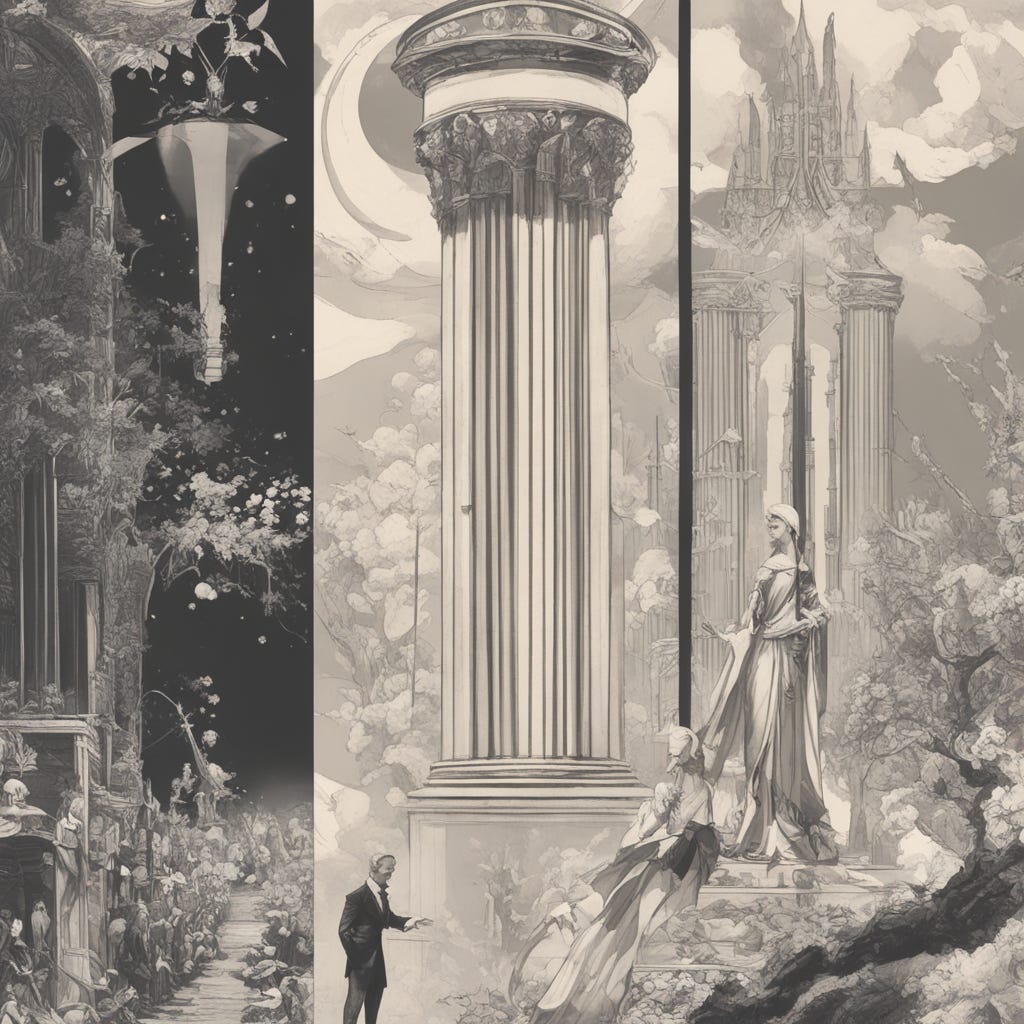
This is a riff about privacy and attention. I have questions, no answers.
Welcome to a piece “From The Future”. Each week, I alternate between essays or fiction.
This is an essay. Last post was fiction for a new story. My next post will be fiction for a novel.
Future + Fiction is the formula for everything, whether it’s an essay, story or chapter.
Most pieces are best read online, via the Substack App, when you have fifteen minutes.
If eyes are the windows to the soul, what do we call the eyes of the panopticon?
If insight begins with the light of new ideas, can we handle an endless kaleidoscope of it?
What if the real monsters under the bed are us, as everyone's overseers and overlords?
A kaleidoscope distracts everyone endlessly, the panopticon takes note of us watching.
Again, this is a riff, a starting point.
The Gods may deal in threes, as trinities and fates, whereas Man has three burdens, three lives.
Our public lives share our select best stories (and our best lies).
Our private lives, cloistered in small circles (we hope), share our least worst lies.
Our secret lives, sequestered faces, which no-one, not even us sometimes, sees.
We’ve managed to get by, if imperfect, balancing our three lives. That’s changed.
All of our selves have been hacked, hijacked, by strangers in strange places for their benefit.
We’ve been hypnotized in the service of spreading rivalrous affections and infections of mimetic algorrhea, deadly for our attention spans, self-esteem, well-being, and worst of all, we’ve lost time for those who care about and love us. These second order effects worsen.
It began long before we became estranged from the ones who mattered, shared and passed around amongst strangers, in exchange for fifteen nanosecond infamies.
The wilds of the open are surrendered each time we are offered a bargain for safety and certainty, in exchange for invisible valuables, our attention and privacy. We think any fee extracted at first is all we pay but that’s the smallest part of the toll.
Not for the first time, we have been beneficiaries of the manicured walled gardens of a promised certainty but how much of it was lasting? How many promises of certainty over time lose their “ground-breaking day” sheen, as incentives change, and what was promised as certain and safe falls into disrepair. Meanwhile, with each exchange, the toll is still extracted, leaving us less of ourselves.
We give up pieces of ourselves each time we accept the bargain. Who prospers? Even as we worry about the latest engines of change, we are distracted by the “Leviathan” of the hour, and those “closest to the king”. Long ago, it meant fiefdoms and serfs, this time we have “platforms” and “users”. The words change but the world stays the same.
When a new oligopoly of certainty descends on everyone, what is sold as “common-sense” ritual, regulation, or rules will become as a wall, as a new iron curtain descends.
Yesterday, royal decree, today, “regulatory capture”. Within such walls, many things will be decided in advance, second order effects worsen, even as the toll rises. When the new bargain is conflated with a new social contract “for the greater good”, once fixed in place, “the fix” is in. The walls close in. After enough time and toll, the open wild fields outside beckon again.
If the few makes the walls for the many, nothing within remains private, for long, for any.
Deflation from technology, hyperinflation in "content", means near-zero cost noise, and real signal is a luxury. A kaleidoscope distracts everyone endlessly, the panopticon takes note of us.
Our lives are targeted for strip-mining by the toll-takers.
Our signal becomes more precious, our privacy becomes more dear as it grows rare.
We navigate with filters through an ocean of noise, now that “content” becomes a buffet of empty calories, a Sargasso of static and streaming words and images. We drown.
We need to hide from the countless eyes of panopticons, while our own eyes must be averted from deceptive distractions of kaleidoscopes, conduits for surrendered attention and privacy.
What do we need for privacy and the protection of our signal?
Blindspots in the panopticon, and blinders for the kaleidoscope.
We think this all began with online networks, this has been going on for a long time.
Sight and light are intertwined, the seeing and watching, whether in a pantheon or a platform.
I think of all the deities that deal in light and by extension sight, watching, including:
Heimdall, the All-seeing Watchman guarding the bridge between the world and Asgard; Helios/Sol the deliverer of light from the sun; Athena/Minerva (whose name came in part from the Etruscan goddess of memory, Menrva), a deity of wisdom and crafts, was a deity of technology; Theia, a Titan of second sight for spirits and clairvoyance, and the glittering light of gold and silver, today would be credited with the lights of endless online distraction; Coeus, Titan of intelligence, logic and inquiry, would fit in the information age’s endless data; and Mimir a Norse god who lost his head (because he defied Odin, king of the Norse Gods) but was still a source of wisdom, paid for, it was said, with one of Odin’s eyes, which seems a fitting reminder of what we trade for still.
Even as ancient rituals were rebooted by new faiths, the walls of places still protected the sanctity of home and hearth, prosperity and wealth, securing their privacy. Whether in a kingdom or a cabin, a space was to be sheltered from the elements and the uninvited, preserving the contents and the lives within.
In an earlier time, there was a deity of lines and boundaries, a god of privacy.
Terminus, the Roman god of borders, of boundaries, fences, walls, left his marks in the form of wooden posts and stone markers at the edge between spaces, and was commemorated with the holiday, Terminalia, which today would be February 23. Respect of the invisible lines of fields, titled lands, land titles, and domain as a deity.
Today, the walls have been dissolved by an entity with two faces, of the always-on, all-showing, Kaleidoscope on one side, and an all-seeing Panopticon on the other. We become watchers of each other, we are watched by others, in an endless circle.
“Always-on, all-showing” distractions are the flip-side of attention. “All Seeing” does not mean all understanding, especially of others from their vantage and points-of-view.
We can deny the thrall of second uninvited sight, with each embrace of first sight. The bargains for mind-share can be broken for more peace of mind. We can reclaim our three lives, the public, private, and secret.
How? I told you in the first line, I had no answers except for one thought:
It’s not too late.
The “essay” above is done, what follows is an informal appendix:
The Sci-fi writer in me riffs below about “how to” make “A Blindspot in The Panopticon” and “Blinders for the Kaleidoscope” (likely to become feedstock for a chapter or story).
I don't stop thinking of the scary, I take more time, make more room, by pushing them aside for beautiful, glorious, and ridiculous. Time for the ridiculous in the below notes.
The American Experiment, mindful of individual liberty, was rooted in private property being intertwined with prosperity but “pursuit of happiness” was used instead.
The regulation of banking led to bigger banks not better banking services necessarily, certainly not a sense of safety, when foxes always run chicken-coops. Perhaps, instead of “privacy of banks”, we invert this to “banks of privacy”.
I think of David Chaum, DigiCash founder, a proto-cypherpunk who published ideas about anonymous cash transfers in 1982, "Blind Signatures for Untraceable Payments. Digicash tried for a decade, perhaps too early, from 1989 to 1998. Gone in bankruptcy, but not forgotten. Eclipsed by a network for an “Internet of Money”. Still early days.
Set aside the “rugging” and “Carlota Perez” economic bust phase, we may have software which helps “Self custody” in a Third Internet, and not just the privacy of financial speech inside money but most importantly our memories and identities.
Our private selves, if unbundled from platforms, reduce attack surfaces for doxx attacks. New tools may include Arweave via Irys (the formerly known Bundlr, an aggregator and poster service for Arweave), to both control what is seen, and what is known, for both privacy and provenance. Machine-based Instrumentalities which must be intimate (and not at the mercy of platforms) help prevent a new serfdom. Zero Knowledge (ZK) reinforces privacy with anonymity and pseudonymity.
People must decide what to turn over to automatic agreements or retain among people. Smart contracts maybe are trust-agnostic, not trust-less, but humans require trustworthy permissions of social contracts bounded in Kantian notions. There is something to this, to find the right boundaries between transactional forms, of ritual and release, without losing human transcendent feelings of reverence and reverie.
Social Graphs give way to something I named “interest grids” in a third Internet.







Was inspired to search "panopticon" from your excellent analysis. Found this gem of internet tech at U. Texas Austin, which apparently has been "in service" for 17 years, so since google & twitter: https://security.utexas.edu/panopticon
Another historic angle, George Lucas first feature, THX1138 https://www.google.com/search?q=lucas+thx1138 examines this exact concept, in dramatic detail. Way back in 1971, the start of all this global electronic connectivity & surveillance... then he went on to create an entire fascistic universe of warring space psychos, which also describes the current lord of X :V